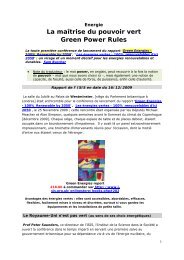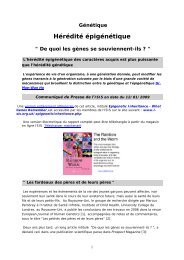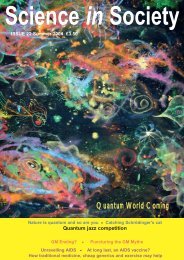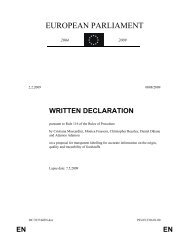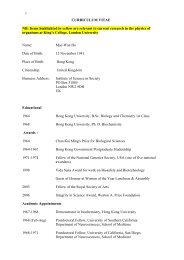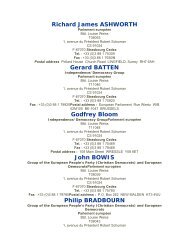Ethiopia goes organic to feed herself - The Institute of Science In ...
Ethiopia goes organic to feed herself - The Institute of Science In ...
Ethiopia goes organic to feed herself - The Institute of Science In ...
You also want an ePaper? Increase the reach of your titles
YUMPU automatically turns print PDFs into web optimized ePapers that Google loves.
New Age <strong>of</strong> Water<br />
47<br />
Water has a collective structure that's extremely flexible<br />
and dynamic, which may explain some <strong>of</strong> its 'anomalies'.<br />
Is Water Special?<br />
Dr. Mae-Wan Ho reports<br />
Water is simple, isn't it?<br />
<strong>The</strong>re is nothing simpler than water as a molecule. Its chemical formula, H 2 O, is almost the first thing in<br />
chemistry that one learns in school. However, its structure in the bulk is multifarious and changeable. <strong>The</strong>re<br />
are 13 known crystalline structures <strong>of</strong> ice that appear under different temperatures and pressures. As a liquid,<br />
water forms dynamic 'flickering clusters' or networks <strong>of</strong> joined up molecules, with intermolecular bonds<br />
that flicker on and <strong>of</strong>f at random. <strong>The</strong> basis for all this complexity lies in the ability <strong>of</strong> a water molecule <strong>to</strong> join<br />
up with its neighbours through a special kind <strong>of</strong> chemical bond, the hydrogen-bond.<br />
<strong>The</strong> hydrogen-bond<br />
To understand how the hydrogen-bond comes about, picture the water molecule consisting <strong>of</strong> an oxygen a<strong>to</strong>m<br />
bonded <strong>to</strong> two hydrogen a<strong>to</strong>ms. <strong>The</strong> water molecule has a shape approximating a tetrahedron, a three-dimensional<br />
triangle with four corners. <strong>The</strong> oxygen a<strong>to</strong>m sits in the heart <strong>of</strong> the tetrahedron, the hydrogen a<strong>to</strong>ms<br />
point <strong>to</strong>wards two <strong>of</strong> the four corners and two 'electron clouds' belonging <strong>to</strong> the oxygen molecule point<br />
<strong>to</strong>wards the remaining corners <strong>of</strong> the tetrahedron. <strong>The</strong> 'electron clouds' are negatively charged, and result<br />
from the a<strong>to</strong>mic structures <strong>of</strong> oxygen and hydrogen and how they combine in the water molecule.<br />
Oxygen has eight (negatively charged) electrons disposed around its positively charged nucleus, rather<br />
like the layers <strong>of</strong> the onion, two in an inner shell and six in the outer shell. <strong>The</strong> inner shell can only accommodate<br />
two electrons, so its capacity is filled. <strong>The</strong> outer shell, however, can hold as many as eight electrons.<br />
<strong>The</strong> hydrogen a<strong>to</strong>m happens <strong>to</strong> have only one electron, so oxygen, by combining with two hydrogen a<strong>to</strong>ms,<br />
completes its outer shell, while the hydrogen a<strong>to</strong>ms each completes its first electron shell with two electrons,<br />
which it shares with the oxygen a<strong>to</strong>m. That is how the usual 'covalent bond' <strong>of</strong> chemistry arises.<br />
<strong>The</strong> oxygen nucleus has more positive charge than the hydrogen, so the shared electrons are slightly<br />
more attracted <strong>to</strong> the oxygen nucleus than <strong>to</strong> the hydrogen nucleus, which makes the water molecule polar,<br />
with two 'electron clouds' <strong>of</strong> negative charge at the opposite poles <strong>to</strong> the two hydrogen a<strong>to</strong>ms, which are each<br />
left with a slight positive charge. (Though quantum mechanical calculations have shown that the two electron<br />
clouds are not really separate from each other.)<br />
<strong>The</strong> positively charged hydrogen <strong>of</strong> one water molecule can thus attract the negatively charged oxygen <strong>of</strong><br />
a neighbouring water molecule <strong>to</strong> form a hydrogen-bond (H-bond) between them. Each molecule <strong>of</strong> water can<br />
potentially form four H-bonds. Two in which it 'donates' its hydrogen a<strong>to</strong>ms <strong>to</strong> the oxygen a<strong>to</strong>ms <strong>of</strong> two other<br />
water molecules, and two in which its oxygen a<strong>to</strong>m 'accepts' one hydrogen a<strong>to</strong>m from each <strong>of</strong> two other water<br />
molecules. <strong>In</strong> other words, each molecule is capable <strong>of</strong> acting as hydrogen 'donors' and 'accep<strong>to</strong>rs' for two<br />
other water molecules, so it has four bonded neighbours, or a '4-coordination'.<br />
Ice structures<br />
Water molecules in ordinary hexagonal ice crystals are close <strong>to</strong> the ideal tetrahedral structure described<br />
above. <strong>The</strong> hydrogen-bonded O-O distances are almost identical, varying between 2.759 Å and 2.761 Å (an<br />
angstrom is 10 -10 m), while the O-O-O angles also vary only slightly between 109.36 o and 109.58 o , which is<br />
close <strong>to</strong> the H-O-H angle <strong>of</strong> 104.52 o <strong>of</strong> the individual water molecule.<br />
However, there are many more forms <strong>of</strong> ice crystals (at least 12 others known) under different temperatures<br />
and pressures, where the bond lengths and angles vary much more widely. For ice II, which forms under<br />
moderate pressure <strong>of</strong> about 5 kbar (1 kbar is equivalent <strong>to</strong> a pressure <strong>of</strong> ~ 1 000 atmospheres), the basic<br />
four-coordinated motif is maintained. But the bond length varies between 2.74 Å and 2.83 Å, while the bond<br />
angle varies between 80 o and 129 o .<br />
<strong>In</strong> liquid water, there is much less constraint compared <strong>to</strong> a solid crystal lattice, and so the variations in<br />
bond length and bond angles take on a much wider continuous range. <strong>In</strong>stead <strong>of</strong> the regular hexagonal (6-<br />
member) ring structure <strong>of</strong> ordinary ice, a snapshot <strong>of</strong> the hydrogen-bonded network shows five, six and<br />
seven-member rings, and even smaller or larger rings. <strong>In</strong>stead <strong>of</strong> the 4-coordination motif, 2-, 3- and even 5-<br />
coordinations are possible, with the H <strong>of</strong> some water molecules in a 'bifurcated' schizophrenic state, seemingly<br />
bonded <strong>to</strong> two different neighbours.<br />
Why is water special?<br />
Why is water so special that life cannot exist without it? According <strong>to</strong> John L Finney <strong>of</strong> University College,<br />
London, the basic tetrahedral structure <strong>of</strong> the water molecule is central <strong>to</strong> the structural versatility <strong>of</strong> water<br />
in the condensed state (solid and liquid). It enables water <strong>to</strong> form extended, flexible networks <strong>of</strong> H-bonded<br />
www.i-sis.org.uk



